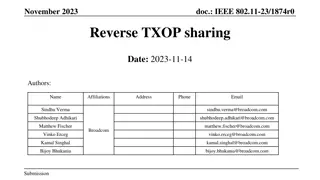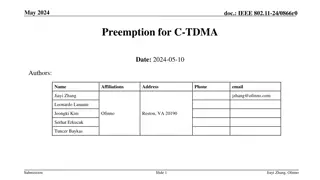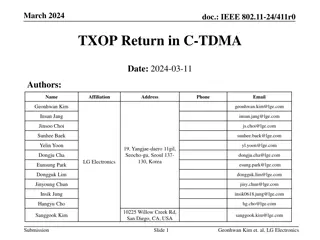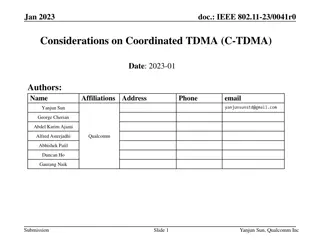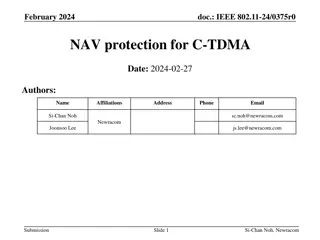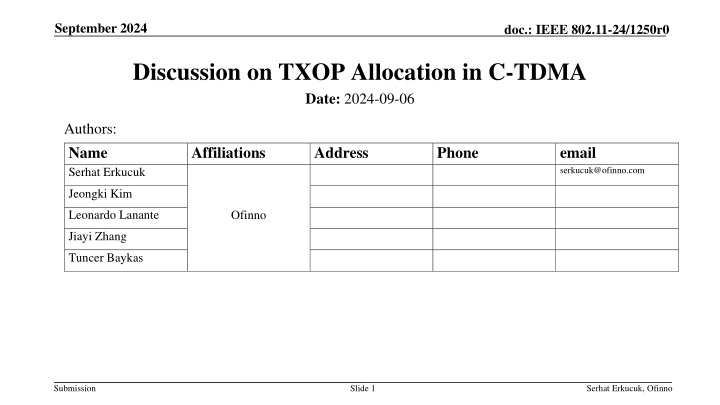
Discussion on TXOP Allocation in C-TDMA for IEEE 802.11-24/1250r0
Explore the challenges and solutions related to TXOP allocation in C-TDMA for IEEE 802.11-24/1250r0. Delve into issues, scheduled allocation, and scenarios where allocation might need adjustments. Discover how sharing APs and shared APs interact during TXOP allocation processes.
Download Presentation

Please find below an Image/Link to download the presentation.
The content on the website is provided AS IS for your information and personal use only. It may not be sold, licensed, or shared on other websites without obtaining consent from the author. If you encounter any issues during the download, it is possible that the publisher has removed the file from their server.
You are allowed to download the files provided on this website for personal or commercial use, subject to the condition that they are used lawfully. All files are the property of their respective owners.
The content on the website is provided AS IS for your information and personal use only. It may not be sold, licensed, or shared on other websites without obtaining consent from the author.
E N D
Presentation Transcript
September 2024 doc.: IEEE 802.11-24/1250r0 Discussion on TXOP Allocation in C-TDMA Date: 2024-09-06 Authors: Name Serhat Erkucuk Affiliations Address Phone email serkucuk@ofinno.com Jeongki Kim Leonardo Lanante Ofinno Jiayi Zhang Tuncer Baykas Submission Slide 1 Serhat Erkucuk, Ofinno
September 2024 doc.: IEEE 802.11-24/1250r0 Introduction In C-TDMA procedure, TXOP allocation is determined by the sharing AP. The procedure works well if: the TXOP allocation is granted to the shared AP as scheduled by the sharing AP. the granted TXOP allocation duration is fully used by the shared AP. In this contribution, we consider various scenarios where TXOP allocation may need to start earlier than its scheduled time or may end before the end of the allocated duration. Submission Slide 2 Serhat Erkucuk, Ofinno
September 2024 doc.: IEEE 802.11-24/1250r0 Issues During TXOP Allocation In C-TDMA, a sharing AP shares its TXOP with one or more shared APs by means of TXOP allocation. Before sharing its TXOP, the sharing AP informs one or more shared APs of upcoming allocations by means of a schedule announcement frame. On receiving the schedule announcement frame, the shared AP plans for an upcoming TXOP allocation. On receiving the TXOP allocation frame, the shared AP starts managing the communication within its BSS for the allocated duration. However, some problems may occur if: a sharing AP assigns TXOP to a shared AP before the scheduled time of TXOP allocation. a shared AP finishes communicating before the end of its TXOP allocation duration. Submission Slide 3 Serhat Erkucuk, Ofinno
September 2024 doc.: IEEE 802.11-24/1250r0 Scheduled TXOP Allocation In a schedule announcement frame, the sharing AP (e.g., AP-1) may inform the shared AP (e.g., AP-2) of an estimate time of TXOP allocation (e.g., the end of duration t1). The sharing AP may plan its upcoming transmissions in its BSS accordingly. The sharing AP then shares its TXOP with the shared AP by means of a TXOP allocation frame after completing its communication (e.g., after the end of duration t1). Receiving the TXOP allocation frame, AP-2 manages the communication in its BSS within the allocated duration (e.g., duration t2). TXOP owned by AP-1 t1 t2 Sched. Announ. (MU-RTS) TXOP Alloc. (MU- RTS TXS) AP-1 Frame exchanges within BSS of AP-1 AP-2 CTS CTS Frame exchanges within BSS of AP-2 Submission Slide 4 Serhat Erkucuk, Ofinno
September 2024 doc.: IEEE 802.11-24/1250r0 Allocating Earlier than Scheduled TXOP Allocation If the sharing AP (e.g., AP-1) finishes communicating before the end of duration t1, AP-1 may transmit a TXOP allocation frame to the shared AP (e.g., AP-2) earlier than the scheduled time. AP-2 may not be ready for receiving a TXOP allocation frame before the end of duration t1 and may not respond to the TXOP allocation frame. Hence, the TXOP allocation may be unsuccessful. AP-2 expects that the TXOP allocation will start after the duration t1, hence, AP-2 may be unavailable during duration t1. TXOP owned by AP-1 t1 t2 t3 Sched. Announ. (MU-RTS) TXOP Alloc. (MU- RTS TXS) Frame exchanges within BSS of AP-1 AP-1 AP-2 CTS Submission Slide 5 Serhat Erkucuk, Ofinno
September 2024 doc.: IEEE 802.11-24/1250r0 Solution: Ability to Receive TXOP Allocation Earlier The shared AP (e.g., AP-2) informs the sharing AP (e.g., AP-1) via a frame (e.g., action, control, management, data, etc.) of its capability (or its operation mode) of receiving a TXOP allocation frame before the scheduled transmission time of the frame. E.g., a capability similar to the TXOP Return Support in TXS Mode 2 capability as in TGbe. Sharing AP transmits a schedule announcement frame to the shared AP informing that the shared AP will be allocated a portion of TXOP (e.g., duration t2) after the duration t1. Finishing communicating before the end of duration t1 and based on the capability (or operation mode) of the shared AP of receiving an early TXOP allocation frame, sharing AP transmits to the shared AP a TXOP allocation frame for allocating a portion of TXOP (e.g., duration t3), where the TXOP allocation frame is transmitted before the end of duration t1. TXOP owned by AP-1 t1 t2 t3 Sched. Announ. (MU-RTS) TXOP Alloc. (MU- RTS TXS) Frame exchanges within BSS of AP-1 AP-1 Frame AP-2 CTS CTS Frame exchanges within BSS of AP-2 Submission Slide 6 Serhat Erkucuk, Ofinno
September 2024 doc.: IEEE 802.11-24/1250r0 Regarding Returning TXOP In earlier contributions, there have been different approaches regarding whether the sharing AP should finish its own communication within its BSS before allocating TXOP to a shared AP or not. In an implementation [1], sharing AP finishes its own communication and allocates TXOP to a shared AP without expecting the return of the TXOP. Accordingly, the shared AP does not return the TXOP to the sharing AP at the end of TXOP allocation. In another implementation [2], sharing AP may need the TXOP returned to itself since either the sharing AP wants to continue with its own communication or it wants to re-schedule TXOP sharing to another shared AP. Therefore, the shared AP has to return the TXOP to the sharing AP by the end of TXOP allocation. Submission Slide 7 Serhat Erkucuk, Ofinno
September 2024 doc.: IEEE 802.11-24/1250r0 Problem when Returning TXOP to Sharing AP If the shared AP (e.g., AP-2) is configured to return the TXOP to the sharing AP (e.g., AP-1) and if AP-2 finishes its communication in own BSS before the end of allocated duration, AP-2 may transmit a TXOP return frame addressed to AP-1. However, AP-1 may already have completed its communications, and may not regain the control of the TXOP. In addition, another shared AP (e.g., AP-3) does not content for the channel (e.g., due to TXOP return frame being addressed to AP-1). TXOP owned by AP-1 allocated duration for AP-2 unused duration Sched. Announ. (MU-RTS) TXOP Alloc. (MU- RTS TXS) AP-1 TXOP return AP-2 CTS CTS Frame exchanges within BSS of AP-2 AP-3 Submission Slide 8 Serhat Erkucuk, Ofinno
September 2024 doc.: IEEE 802.11-24/1250r0 Solution: Requesting TXOP Return Sharing AP transmits to the shared AP an indication (TXOP return flag = 1) in the TXOP allocation frame or schedule announcement frame. Based on the indication and the remaining duration of the TXOP allocation, the shared AP transmits a TXOP return frame. TXOP return frame may be a management, action, MU-RTS TXS trigger, QoS null/data or a CF-end frame (RA: Sharing AP). Sharing AP transmits to the shared AP an indication (TXOP return flag = 0) in the TXOP allocation frame or schedule announcement frame. Based on the indication and the remaining duration of the TXOP allocation, the shared AP transmits a TXOP truncation frame. TXOP return frame may be a CF-end frame (RA: BC). Submission Slide 9 Serhat Erkucuk, Ofinno
September 2024 doc.: IEEE 802.11-24/1250r0 TXOP Allocation to Multiple Shared APs In another example, the sharing AP (e.g. AP-1) may transmit a schedule announcement frame to multiple shared APs (e.g., AP-2, AP-3) followed by a TXOP allocation frame. E.g, TXOP allocation may be via a single MU-RTS TXS TF to AP-2 and AP3 (as shown below), or via consecutive MU-RTS TXS TFs individually to AP-2 and AP-3. TXOP owned by AP-1 t2 t1 Sched. Announ. (MU-RTS) TXOP Alloc. (MU- RTS TXS) AP-1 AP-2 CTS CTS CTS Frame exchanges within BSS of AP-2 AP-3 CTS CTS CTS Frame exchanges within BSS of AP-3 Submission Slide 10 Serhat Erkucuk, Ofinno
September 2024 doc.: IEEE 802.11-24/1250r0 Early Ending of Communication in BSS The first allocated shared AP (e.g., AP-2) may finish communicating before the end of duration t1. Based on a configuration, AP-2 may wait until the end of duration t1 with no further action (or in another configuration not shown here, AP-2 may return the TXOP to AP-1). As a result, the second allocated shared AP (e.g., AP-3) may have to wait until the beginning of the duration t2 to start communicating as scheduled by the MU-RTS TXS TF. Accordingly, there may be an unused duration. TXOP owned by AP-1 t2 t1 unused duration Sched. Announ. (MU-RTS) TXOP Alloc. (MU- RTS TXS) AP-1 Frame exchanges within BSS of AP-2 AP-2 CTS CTS CTS AP-3 CTS CTS CTS Frame exchanges within BSS of AP-3 Submission Slide 11 Serhat Erkucuk, Ofinno
September 2024 doc.: IEEE 802.11-24/1250r0 Solution TXOP Allocation by a Shared AP Sharing AP (e.g., AP-1) transmits to the shared APs (e.g., AP-2, AP-3) TXOP allocation information. If AP-2 finishes communicating before the end of duration t1, AP-2 sends a frame (e.g., MU-RTS TXS TF) that triggers AP-3 to start communicating during the duration t1. This operation may be configured in advance or AP-1 may instruct AP-2 to do so by transmitting an indication in the schedule announcement frame or the TXOP allocation frame. TXOP owned by AP-1 t1 t2 t3 Sched. Announ. (MU-RTS) TXOP Alloc. (MU- RTS TXS) AP-1 CTS Frame Frame exchanges within BSS of AP-2 AP-2 CTS CTS AP-3 CTS CTS CTS Frame exchanges within BSS of AP-3 Submission Slide 12 Serhat Erkucuk, Ofinno
September 2024 doc.: IEEE 802.11-24/1250r0 Conclusion In this contribution, we considered various scenarios of TXOP allocation in the C-TDMA procedure. We demonstrated some problems that may occur during the procedure. For example, a sharing AP may assign TXOP to a shared AP before the scheduled time of TXOP allocation, and the shared AP may not respond. As another example, if a shared AP finishes communicating before the end of its TXOP allocation duration, the shared AP may not know how to take an appropriate action. Accordingly, some solutions are proposed to these problems, where: capability (or operation mode) of receiving an early TXOP allocation frame for the shared AP is defined. the sharing AP instructs the shared AP for TXOP return or TXOP truncation. the shared AP can trigger another shared AP for the next TXOP allocation. Submission Slide 13 Serhat Erkucuk, Ofinno
September 2024 doc.: IEEE 802.11-24/1250r0 References [1] 24/0093r3, NAV Setting for Coordinated TDMA [2] 24/0423r0, NAV Rules in C-TDMA Submission Slide 14 Serhat Erkucuk, Ofinno

